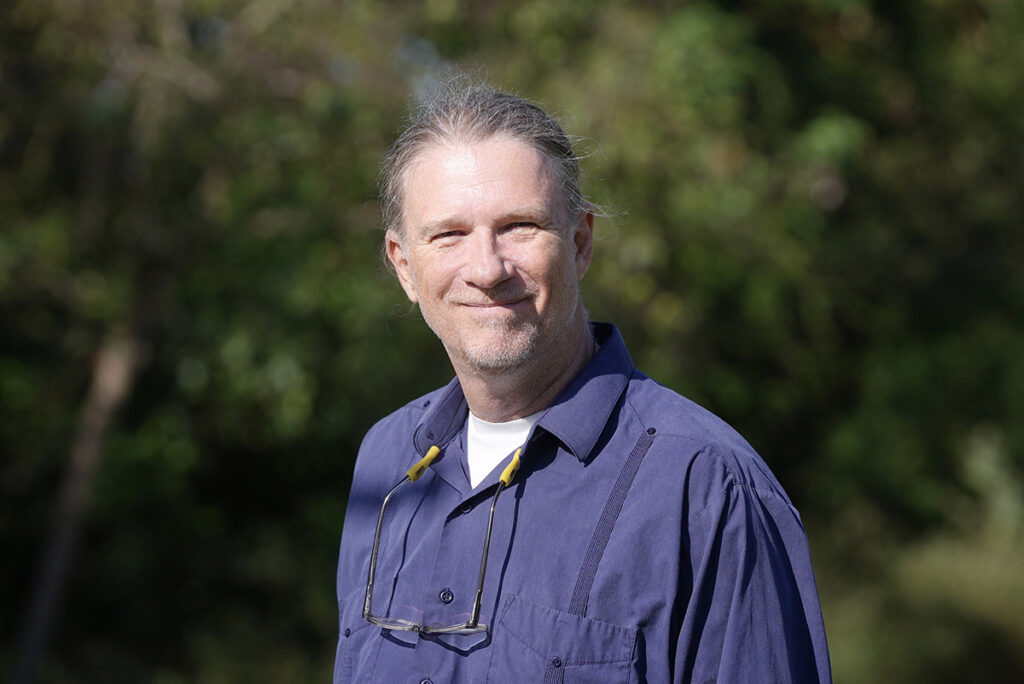Karl Berg, an associate professor for the UTRGV School of Integrative Biological and Chemical Sciences, has been researching parrots for more than 30 years.

PHOTO COURTESY JESÚS ALFÉREZ
In his most recent research trip to Venezuela, Berg found a significant stage called “the vocal babbling stage.”
“They have a few other vocalizations that they learn in the nest, but it’s always fairly clear why they’re doing it,” he said. “When we discovered the vocal babbling stage, it was weird. There was no obvious context. In fact, we recorded this when lone individuals are inside the nest.”
Berg said he makes spectrograms to get a visual representation of the sound.
“That allows us to characterize the different types of sounds they make and taking measurements, frequency, duration and bandwidth … to help describe the acoustic structure,” he said. “This babbling phase was very complex to everything they’ve done prior in development.”
Berg described the babbling as very quiet. Something that had not been found with parrots in captivity.
“I was pretty excited when I first heard it,” he said. “I’ve been recording pretty intensively ever since. We have about 15,000 hours that we have recorded inside the nest cavities.”
The nest cavities allow Berg and his team to get an insight to the parrots.
“Over the last 15 years or so has come from recording inside the nest cavities, so a lot of the work we’ve done is focused on the development of the nestlings,” he said.
The nest cavities are made out of PVC pipe with installed cameras.
“It turned out to be a really nice system where we could install cameras inside the nest cavities,” Berg said. … “We don’t make them breed in these cavities. They naturally gravitate towards them. Putting video cameras in there really helped us to start to put together the vocal development of the nestlings but also the interactions with the parents.”
The assistant professor said one of the biggest challenges he has faced during his time doing research would be money.
“The study began in 1987,” he said. “We just finished the 36-consecutive field season last year in December. Even before we’re done with the field season, I have to be thinking about how I’m going to finance the next field season. So if we decide, ‘Well, I didn’t have money. I’m not going to Venezuela this year’ … the study kind of falls apart.”
Abigail Pozulp, lecturer for the School of Integrative Biological and Chemical Sciences, was a graduate student from 2018-2021 who Berg helped design a project to observe the vocal behavior of Red Crowned Parrots, found here in the Rio Grande Valley.
“He was very supportive, he helped me the whole way,” Pozulp said. “It was a little different from the research that he had done before with green-rumped parrots in Venezuela, so it was a really exciting project.”
She said the red rumped parrots are an endangered species that is heavily understudied. She was able to study their vocalization of these parrots and found different vocalization patterns every time they would vocalize.
“Dr. Berg’s research in Venezuela, he had a team of local people that collected his data,” Pozulp said. “We are so lucky to have a wild parrot species in our town. We are really one of the only towns in the United States to have that.”
She said parrots are very intelligent, social and different from other birds “in a lot of unique ways.”
“In 2022, [Berg] and I worked together to put a camera in the nest of a red-crowned parrot on campus,” Pozulp said. “We got to record one red-crowned baby grow up and record it babbling, so that’s probably the first time anyone has ever recorded a wild red-crowned parrot from the time it hatches until it fledges.”
Berg said he thinks it is important to find the explanation as to why parrots are able to vocalize and other groups are not.
“Animals are amazing, especially when you can study them in nature,” he said. “And we study them in captivity and we sort of see all sorts of weird things. Some of them are important and others are sort of anecdotes but, in nature, we get a chance to really understand how things function.”





